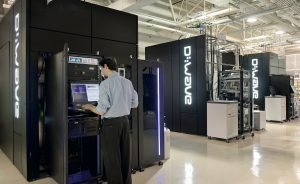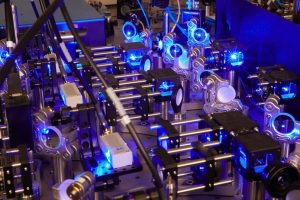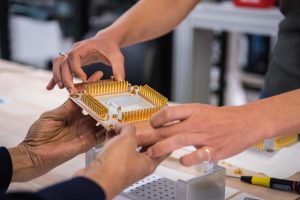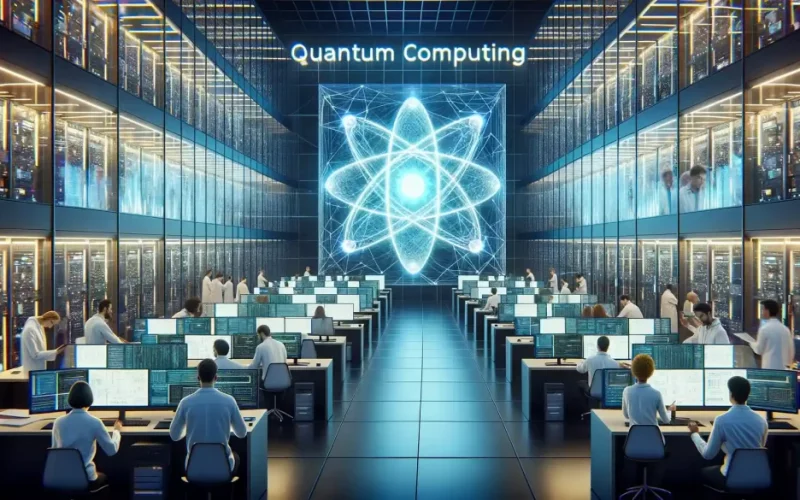Quantum computing has moved beyond the realm of theoretical science into real-world applications, offering the potential to solve problems that were previously deemed unsolvable by classical computers. Quantum computers leverage the principles of quantum mechanics to process information in fundamentally different ways, enabling them to outperform classical computers in certain tasks.
In 2025, quantum computing is on the brink of transforming industries ranging from pharmaceuticals to climate science, logistics, and cryptography. Although challenges remain, significant advancements have been made, propelling us closer to practical, scalable quantum systems. This article explores the current state of quantum computing, its advancements, applications, benefits, and real-world case studies, providing a holistic view of this transformative technology.
Quantum Hardware: The Engine Behind the Revolution

Quantum computing’s power stems from its hardware, the physical systems that implement quantum operations. Several approaches to quantum hardware are being developed, each with its strengths and challenges.
Superconducting Qubits
Superconducting qubits have emerged as one of the most promising candidates for building scalable quantum computers. Companies like IBM, Google, and Intel have been at the forefront of this technology. These qubits are created by passing a current through a superconducting circuit, enabling quantum states to be encoded in tiny superconducting loops.
In 2025, IBM’s Condor processor, with over 1,000 qubits, marks a milestone in the evolution of superconducting qubits. IBM’s Eagle processor (released in 2021) demonstrated a breakthrough with 127 qubits, and Condor takes this a step further, showing that quantum systems with hundreds of qubits are achievable. Google’s Sycamore processor, used to achieve the famous quantum supremacy milestone in 2019, has also been upgraded, offering better performance and fewer error rates.
Benefits: Superconducting qubits are versatile and relatively easy to manipulate, allowing companies to experiment with a variety of quantum algorithms. Moreover, their fast operation time allows for efficient calculations in comparison to other quantum systems.
Trapped-Ion Quantum Computers
Trapped-ion quantum computers, developed by companies like IonQ and Honeywell, use ions (charged atoms) trapped in electromagnetic fields. Laser beams are used to manipulate the ions’ quantum states. While this method has lower qubit counts than superconducting qubits, it offers incredibly high fidelity, meaning fewer errors in computation.
In 2025, IonQ has demonstrated quantum computers with more than 20 high-fidelity qubits, and researchers are working on scaling this technology to 100+ qubits. Honeywell, with its new H-Series Quantum Computer, focuses on creating high-precision quantum devices for industrial applications.
Benefits: The main advantage of trapped-ion quantum computing lies in its low error rates and excellent qubit coherence times, making it ideal for quantum simulations, cryptography, and machine learning applications.
Topological Qubits

Microsoft has made notable strides in the development of topological qubits, which offer a promising solution to one of the key challenges in quantum computing—error correction. Topological qubits are designed to be more stable and less prone to environmental noise, making them potentially more scalable and reliable than other types of qubits.
In recent years, Microsoft has demonstrated prototypes of topological qubits that show promise in terms of error resistance. While still in early stages, topological qubits could eventually allow quantum computers to operate for extended periods without requiring frequent recalibration.
Benefits: Topological qubits may lead to more robust quantum systems, which could enable large-scale, fault-tolerant quantum computers that are both powerful and reliable.
Quantum Software and Algorithms: Unlocking Quantum Potential
As quantum hardware continues to advance, so does the software that runs on these quantum systems. Several software platforms are helping researchers and developers leverage quantum computing’s potential.
Quantum Programming Languages
To interact with quantum computers, specialized programming languages and software development kits (SDKs) are required. Leading platforms include:
- IBM’s Qiskit: A comprehensive open-source SDK for quantum computing that allows developers to design and run quantum algorithms on IBM’s quantum processors. It supports quantum circuits and quantum error correction.
- Google’s Cirq: Cirq is tailored to Google’s quantum processors, providing an open-source framework for building and executing quantum circuits.
- Rigetti’s Forest: Rigetti offers its Forest platform, which includes Quil (a quantum instruction language) and a simulator for testing quantum algorithms.
These programming environments have greatly lowered the barrier to entry, allowing researchers and developers to experiment with quantum computing algorithms without needing to understand the complex physical hardware.
Benefits: These SDKs provide a bridge between classical computing and quantum systems, facilitating easier development of hybrid quantum-classical applications.
Quantum Machine Learning (QML)
Quantum machine learning is an exciting field where quantum computers are used to improve traditional machine learning algorithms. By utilizing quantum properties such as superposition and entanglement, quantum computers can theoretically process large datasets more efficiently than classical machines.
For instance, Google and IBM are developing quantum algorithms that speed up the training of machine learning models. In early experiments, quantum-enhanced algorithms have shown promise in boosting the performance of neural networks, clustering algorithms, and data analysis tools.
Benefits: Quantum machine learning holds the potential to revolutionize AI by enabling faster data processing and more efficient optimization algorithms. This could lead to breakthroughs in fields like natural language processing, recommendation systems, and predictive analytics.
Quantum Cryptography

Quantum computers also pose a threat to current cryptographic systems, as they can potentially break traditional encryption methods like RSA and ECC. However, quantum cryptography offers solutions to this problem through methods like Quantum Key Distribution (QKD). QKD uses the principles of quantum mechanics to create secure communication channels that are immune to eavesdropping.
In 2025, China Telecom and AT&T are running pilot programs using quantum cryptography to secure communications over long distances. Additionally, several global financial institutions are exploring the use of quantum-safe encryption to protect sensitive information from future quantum threats.
Benefits: Quantum cryptography provides an unprecedented level of security, making it vital for the future of secure communications, especially in banking, defense, and governmental systems.
Real-World Applications of Quantum Computing
Quantum computing is not just a theoretical concept—it is making its way into real-world applications. Various industries are already experimenting with quantum technologies to solve complex problems.
Drug Discovery and Material Science
Quantum computing has the potential to transform industries like pharmaceuticals and materials science by enabling faster and more accurate simulations of molecular interactions. Classical computers struggle with simulating complex molecules due to their enormous computational requirements. Quantum computers, however, can model these interactions at the quantum level, making it easier to discover new drugs and materials.
Case Study: Bayer partnered with IBM in 2025 to use quantum computing for drug discovery. Using IBM’s Qiskit and quantum simulators, Bayer has been able to model protein-ligand interactions, which is a crucial part of developing new pharmaceuticals.
Benefits: Quantum computing enables researchers to conduct experiments virtually, speeding up the drug discovery process and reducing costs. In materials science, quantum computers can potentially unlock the creation of new materials with properties that were previously impossible to predict.
Optimization Problems
Quantum computing’s ability to solve optimization problems is one of its most valuable features. Classical computers are often slow at solving large-scale optimization problems, such as route planning, supply chain optimization, and financial portfolio management. Quantum algorithms, on the other hand, can potentially find better solutions much more quickly.
Case Study: Volkswagen partnered with DHL to explore quantum computing for logistics. They used quantum algorithms to optimize delivery routes for trucks, reducing travel time and fuel consumption. These improvements were achieved through hybrid quantum-classical systems running on IBM’s quantum cloud.
Benefits: Quantum optimization algorithms have the potential to significantly reduce costs and time in logistics, manufacturing, and finance by finding more efficient solutions to complex optimization problems.
Climate Modeling
Quantum computers are also being used to simulate complex climate models. These simulations require an enormous amount of computational power to predict long-term climate changes, atmospheric patterns, and weather systems.
Case Study: NASA is collaborating with Microsoft and D-Wave to run climate simulations on quantum computers. These simulations help in understanding the impact of human activities on the environment and predicting future climate scenarios.
Benefits: Quantum computers can model highly complex systems more accurately, improving our understanding of climate change and enabling more effective policy decisions. This could help mitigate the effects of global warming.
Challenges and Future Directions

Despite the remarkable progress made in quantum computing, several challenges remain:
Quantum Error Correction
Quantum computers are highly susceptible to noise and errors, making quantum error correction a critical area of research. While there has been significant progress in developing error-correcting codes, achieving practical, fault-tolerant quantum computing is still a distant goal. Researchers are exploring surface codes and topological codes to improve error resilience.
Scalability
Scaling quantum systems to the millions of qubits necessary for solving complex, real-world problems remains a huge challenge. While prototypes with hundreds of qubits are already in operation, achieving the required qubit count while maintaining low error rates will be a major milestone.
Quantum-Classical Integration
Until quantum computers can be scaled to solve all types of problems, hybrid quantum-classical systems will continue to play a crucial role. These systems combine the power of quantum processors for specific tasks and classical computers for others. This hybrid approach is expected to be the key to unlocking practical quantum applications in the short term.
Conclusion
Quantum computing in 2025 is no longer a speculative field; it is a rapidly evolving technology with profound implications for science, industry, and society. From hardware advances such as superconducting and trapped-ion qubits to software innovations in quantum machine learning and cryptography, the progress is accelerating. Real-world applications in drug discovery, optimization, and climate modeling are already proving quantum computing’s potential.
While the path to large-scale, fault-tolerant quantum computers is still filled with challenges, the current breakthroughs in quantum hardware and algorithms bring us closer to the day when quantum computing will revolutionize industries across the globe.










